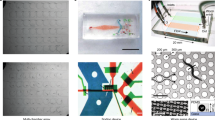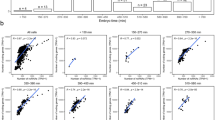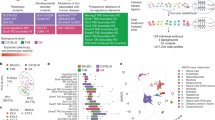Abstract
A key challenge of functional genomics today is to generate well-annotated data sets that can be interpreted across different platforms and technologies. Large-scale functional genomics data often fail to connect to standard experimental approaches of gene characterization in individual laboratories. Furthermore, a lack of universal annotation standards for phenotypic data sets makes it difficult to compare different screening approaches. Here we address this problem in a screen designed to identify all genes required for the first two rounds of cell division in the Caenorhabditis elegans embryo. We used RNA-mediated interference to target 98% of all genes predicted in the C. elegans genome in combination with differential interference contrast time-lapse microscopy. Through systematic annotation of the resulting movies, we developed a phenotypic profiling system, which shows high correlation with cellular processes and biochemical pathways, thus enabling us to predict new functions for previously uncharacterized genes.
This is a preview of subscription content, access via your institution
Access options
Subscribe to this journal
Receive 51 print issues and online access
$199.00 per year
only $3.90 per issue
Buy this article
- Purchase on Springer Link
- Instant access to full article PDF
Prices may be subject to local taxes which are calculated during checkout




Similar content being viewed by others
References
Lum, L. et al. Identification of Hedgehog pathway components by RNAi in Drosophila cultured cells. Science 299, 2039–2045 (2003)
Gönczy, P. et al. Functional genomic analysis of cell division in C. elegans using RNAi of genes on chromosome III. Nature 408, 331–336 (2000)
Kamath, R. S. et al. Systematic functional analysis of the Caenorhabditis elegans genome using RNAi. Nature 421, 231–237 (2003)
Clemens, J. C. et al. Use of double-stranded RNA interference in Drosophila cell lines to dissect signal transduction pathways. Proc. Natl Acad. Sci. USA 97, 6499–6503 (2000)
Kiger, A. et al. A functional genomic analysis of cell morphology using RNA interference. J. Biol. 2, 27.1–27.15 (2003)
Maeda, I. et al. Large-scale analysis of gene function in Caenorhabditis elegans by high-throughput RNAi. Curr. Biol. 11, 171–176 (2001)
Piano, F. et al. Gene clustering based on RNAi phenotypes of ovary-enriched genes in C. elegans . Curr. Biol. 12, 1959–1964 (2002)
Walhout, A. J. et al. Integrating interactome, phenome, and transcriptome mapping data for the C. elegans germline. Curr. Biol. 12, 1952–1958 (2002)
Schneider, S. Q. & Bowerman, B. Cell polarity and the cytoskeleton in the Caenorhabditis elegans zygote. Annu. Rev. Genet. 37, 221–249 (2003)
Gönczy, P. et al. Dissection of cell division processes in the one cell stage Caenorhabditis elegans embryo by mutational analysis. J. Cell Biol. 144, 927–946 (1999)
Strome, S. & Wood, W. B. Generation of asymmetry and segregation of germ-line granules in early C. elegans embryos. Cell 35, 15–25 (1983)
Fire, A. et al. Potent and specific genetic interference by double-stranded RNA in Caenorhabditis elegans . Nature 391, 806–811 (1998)
The C. elegans Sequencing Consortium. Genome sequence of the nematode C. elegans: a platform for investigating biology. Science 282, 2012–2018 (1998)
Parrish, S. et al. Functional anatomy of a dsRNA trigger: differential requirement for the two trigger strands in RNA interference. Mol. Cell 6, 1077–1087 (2000)
Zipperlen, P. et al. Roles for 147 embryonic lethal genes on C. elegans chromosome I identified by RNA interference and video microscopy. EMBO J. 20, 3984–3992 (2001)
Askjaer, P. et al. Ran GTPase cycle and importins alpha and beta are essential for spindle formation and nuclear envelope assembly in living Caenorhabditis elegans embryos. Mol. Biol. Cell 13, 4355–4370 (2002)
Gönczy, P. et al. Cytoplasmic dynein is required for distinct aspects of MTOC positioning, including centrosome separation, in the one cell stage Caenorhabditis elegans embryo. J. Cell Biol. 147, 135–150 (1999)
Davy, A. et al. A protein–protein interaction map of the Caenorhabditis elegans 26S proteasome. EMBO Rep. 2, 821–828 (2001)
Giaever, G. et al. Functional profiling of the Saccharomyces cerevisiae genome. Nature 418, 387–391 (2002)
Brenner, S. The genetics of Caenorhabditis elegans . Genetics 77, 71–94 (1974)
Altschul, S. F. et al. Gapped BLAST and PSI-BLAST: a new generation of protein database search programs. Nucleic Acids Res. 25, 3389–3402 (1997)
Acknowledgements
We thank M. Srayko, C. Cowan, L. Pelletier and W. B. Wood for critical reading of the manuscript, and M. Volkmer and S. Schloissnig for their help on the completion of the online Phenobank database. This work was supported in part by the German government through a DLR grant. A.C. was supported by the MRC, UK.
Author information
Authors and Affiliations
Corresponding author
Ethics declarations
Competing interests
The authors declare that they have no competing financial interests.
Supplementary information
Supplementary Table 1
Phenotypic and functional classification of all genes with early embryonic (DIC) phenotypes. (XLS 337 kb)
Supplementary Table 2
Comparison between RNAi and conventional genetics. (XLS 26 kb)
Supplementary Table 3
Comparison of screening coverage and detection accuracy for early embryonic phenotypes in the present study versus Zipperlen et al. and Piano et al. (XLS 25 kb)
Rights and permissions
About this article
Cite this article
Sönnichsen, B., Koski, L., Walsh, A. et al. Full-genome RNAi profiling of early embryogenesis in Caenorhabditis elegans. Nature 434, 462–469 (2005). https://doi.org/10.1038/nature03353
Received:
Accepted:
Issue Date:
DOI: https://doi.org/10.1038/nature03353
This article is cited by
-
Identification and prioritisation of potential vaccine candidates using subtractive proteomics and designing of a multi-epitope vaccine against Wuchereria bancrofti
Scientific Reports (2024)
-
Devo-Aging: Intersections Between Development and Aging
GeroScience (2023)
-
Cilia regeneration requires an RNA splicing factor from the ciliary base
Cell Regeneration (2022)
-
Functional characterization of the pUceS8.3 promoter and its potential use for ectopic gene overexpression
Planta (2022)
-
Statistical image processing quantifies the changes in cytoplasmic texture associated with aging in Caenorhabditis elegans oocytes
BMC Bioinformatics (2021)
Comments
By submitting a comment you agree to abide by our Terms and Community Guidelines. If you find something abusive or that does not comply with our terms or guidelines please flag it as inappropriate.



